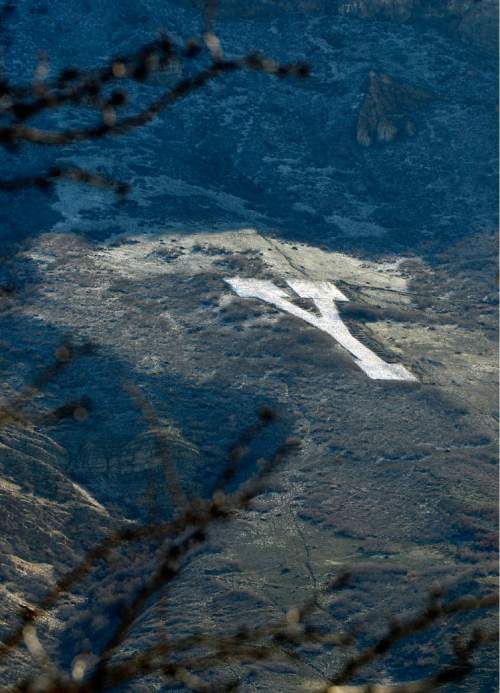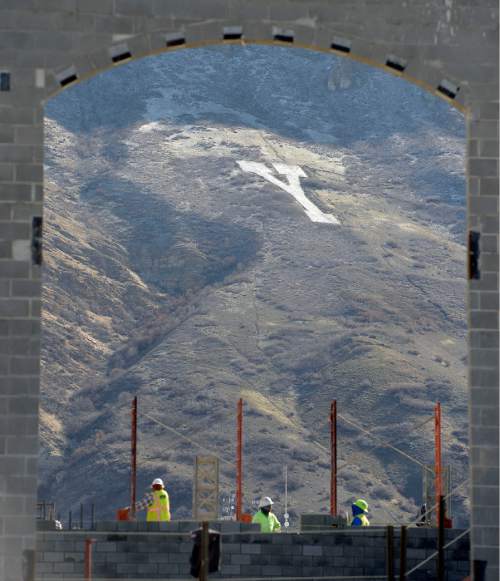This is an archived article that was published on sltrib.com in 2016, and information in the article may be outdated. It is provided only for personal research purposes and may not be reprinted.
Brigham Young University has become the sole owner of its signature landmark — and all it took was $180,000, four years and an act of Congress.
With Y Mountain now the exclusive property of the private Provo school, students, alumni and outdoors enthusiasts are celebrating. They expect the land-ownership transfer from the U.S. Forest Service to improve safety on the steep one-mile path that leads to the block letter.
The thought of upgrades is reassuring for 2001 BYU graduate Leslie Findlay, who ran the trail as a student and hiked it when she was pregnant with her first child, Hugh, now 12. When the boy was 3 months old, Findlay hiked to the Y at night with Hugh and husband Jacob to illuminate it with lightbulbs, part of an annual homecoming tradition.
Even after moving back home to Arizona, returning to the path remains a ritual on yearly visits back to Utah.
"Once you get to the Y, it's really steep and it's kind of scary now," said the piano teacher and mother of six. "Having kids, it makes me nervous to take the babies all the way up."
The Findlays' university now can alter the path without consulting with the Forest Service. The school, owned by The Church of Jesus Christ of Latter-day Saints, is already planning a series of upgrades to repair erosion on switchbacks and the summit, which requires some scrambling.
The additional 80 acres surrounding the top two-thirds of the letter cost $180,000, according to Utah County records of the transfer dated Feb. 16.
U.S. Rep. Jason Chaffetz, who was a BYU football kicker, brought a 2012 resolution allowing the transfer at his school's request. The Utah Republican told lawmakers at the time that BYU wanted to provide water on the route and had the resources to better clean up litter.
But it was another Utah Republican and BYU alumnus, Sen. Orrin Hatch, who successfully tucked permission for the transfer inside a national defense bill last year. Provo Mayor John Curtis also lent a hand, testifying in favor of the legislation.
The law is personal for Hatch, who graduated with a history degree in 1959.
"I have fond memories of hiking up the mountain as a BYU student with buckets of water, lime and salt to whitewash the Y," the senior senator said through a spokesman. "Y Mountain has always been a special place to me, and I am glad that future generations of students will be able to enjoy it as well."
BYU President Kevin Worthen celebrated his school's new deed for 81 acres of forest land, noting the icon painted to the east of campus is one of the first things campus visitors spot.
"We intend to make sure," Worthen said in a statement, "the Y continues to stand as a welcoming symbol to all who come to Utah Valley."
The history of the letter, 380 feet tall and 130 feet wide, dates back more than a century, when members of the junior class at the former Brigham Young High School lugged sacks of lime up the mountain to paint their graduation year on the dirt. Other classes retaliated by erasing the "1907," according to the high school alumni group's Web page.
Administrators put an end to the scuffle by commissioning a mathematics professor and his students to write "BYU" above upper campus. But Harvey Fletcher later wrote in his autobiography, the alumni group contends, that the daylong project proved too much for the workers. After completing the Y, the crew abandoned plans for the other two letters. Some fainted on the way down, Fletcher wrote. They hadn't thought to pack breakfast or lunch.
Students such as Hatch followed the same path each spring to whitewash the Y until the mid-1970s, when a helicopter was brought in to do the chore. It now is covered in concrete and illuminated five times per year: freshman orientation, homecoming, Y Days and graduations in April and August.
Repairing the erosion will take some time, the school acknowledged, adding that hikers and runners should expect intermittent closures this year. And while BYU hopes to improve access for many, not every type of adventure will be welcome.
As a freshman in fall 1969, Mark Emmet attempted to drive his 1957 Chrysler more than halfway to the north end of the trail before he got stuck.
"I can't remember," he wrote via The Salt Lake Tribune's Public Insight Network, "how we managed to get the car turned around and off the mountain."
aknox@sltrib.com Twitter: @anniebknox







